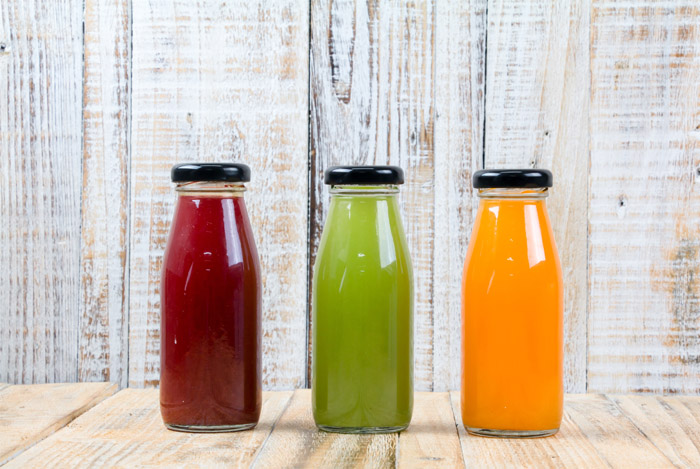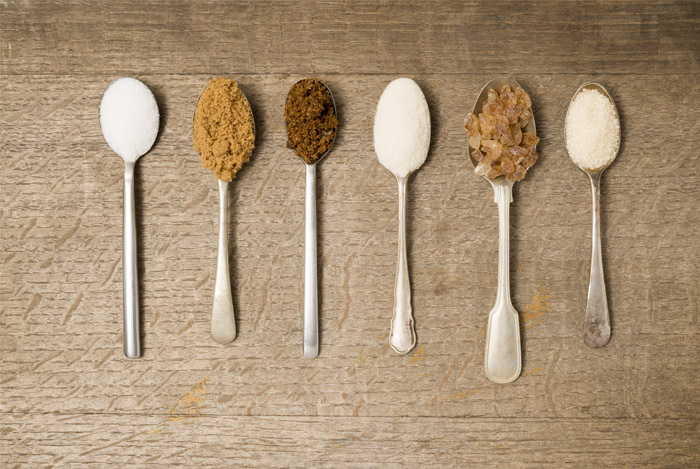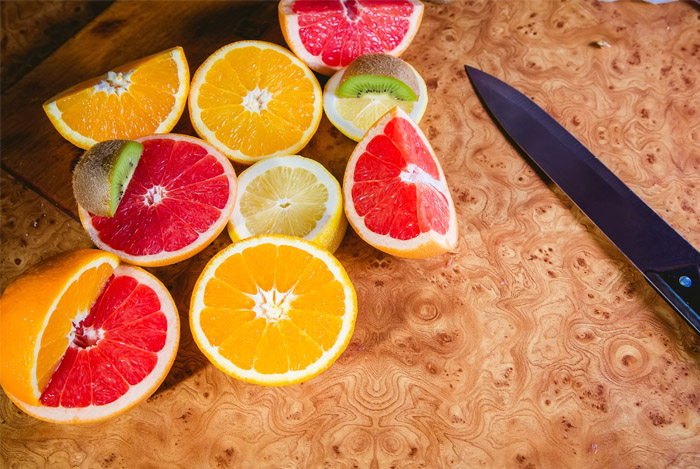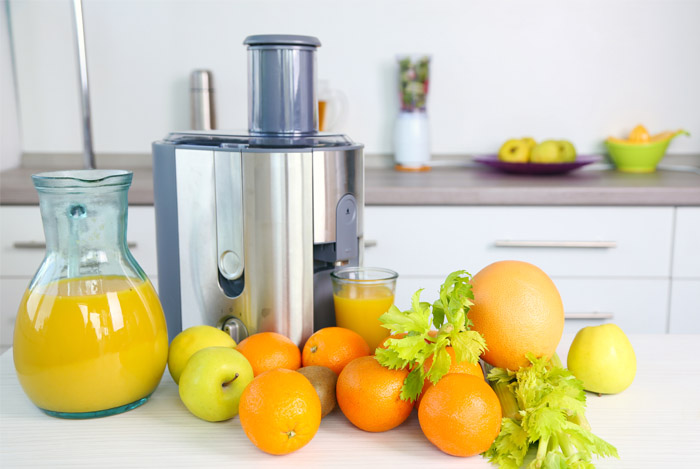Nowadays you can’t call yourself a health fan without owning a juicer (or at least a blender) to make your own fruit and veggie-packed juices and smoothies.
You can literally add handfuls of nutritious superfoods to an easy-to-drink beverage instead of sitting down to nosh on a three pound salad. Sounds like the healthiest thing you can give your body when you’re short on time, right?
The U.S. Department of Agriculture (USDA) tells us that women should aim for 1.5–2 cups of fruit each day, and men should stick to 2 cups. Fruit juice is an easy way to fulfill these requirements because 1 cup of juice equals 1 cup of fruit.
And according to one study: “92.4 percent of us don’t hit our fruit target”. Maybe that’s because most of us don’t have the time to juice every day.
Us busy people are lured by the myriad of delicious fruit juices on the market for a more convenient option. How can we resist juices that promise to deliver farmstand quality, with most of the same vitamins and minerals as real fruit, without the hassle?
Research company Mintel says that: “83% of people drink fruit juice, a juice drink, or smoothie at least once a week”.
Many people believe they’re making the right choice when they reach for the bottle of fruit juice instead of the liter of soda. In fact, “76% [of consumers] believe juice and smoothies to be healthy”.
So I guess I have to break the bad news to you 76%: fruit juice may be much worse than soda.
Check the Label on Your Juice
 Your heart may be in the right place, but the makers of your favorite juices are not thinking about your health; they’re thinking about their bottom line.
Your heart may be in the right place, but the makers of your favorite juices are not thinking about your health; they’re thinking about their bottom line.
Even when you buy bottles labeled “100% juice”, you’re still not guaranteed to avoid additives, preservatives, and flavorings. These types of processed ingredients in our food are what’s making us sick.
When you see the words ‘fruit concentrate’ on your bottle, just back away.
See, juice companies need to pick and store as much of their fruit during the harvesting season as possible. In order to keep their juice from going bad, they have to heat the juice and remove the water so it cooks down to a concentrated syrup. Chemicals and other byproducts are also added, FYI.
When they go to package the juice, they add water and flavorings to make the juice resemble the fresh juice you think you’re buying. It saves them money and allows their juice to stay shelf-stable longer. Hello preservatives!
They also have to add vitamins and minerals back in that were most likely destroyed during the ‘cooking’ process.
But what about juices labeled “not from concentrate”?
According to the book Squeezed: What You Don’t Know About Orange Juice, author Alissa Hamilton says that orange juice companies forgo the juice concentrate and do something entirely different: they suck out all of the oxygen in the holding tanks so the juice can stay stable for up to a year.
Then they reconstitute this ‘juice’ with “flavor packs” made of “chemicals that make up orange essence and oil”. You know, the same stuff used to make pretty citrus scents in your perfume or cologne.
You’ll even find ethyl butyrate in most North American orange juices because flavor engineers discovered that Americans associated the chemical with fresh squeezed oranges.
That’s just one of close to 4,000 additives the FDA approved for use in our food, which doesn’t need to be on the ingredients label.
Hamilton goes on to say that: “Industry insiders say the formula for fresh orange flavor is as elusive as the formula for Coke”.
That’s funny; I thought the only ingredient in that OJ recipe was fresh squeezed oranges…
So what effect does sugary fruit juice have on our bodies?
Within the First 10 Minutes
 The sugar in your fruit juice immediately makes your brain happy. It then releases those “feel good” chemicals, which literally make you feel good while you’re drinking.
The sugar in your fruit juice immediately makes your brain happy. It then releases those “feel good” chemicals, which literally make you feel good while you’re drinking.
Cue your happy dance.
However, your brain doesn’t care if you’re drinking sugar from a can of soda or sugar from a glass of juice, and that’s a problem.
Check out the nutritional facts for 8 oz. of these three popular fruit juices:
- Tropicana Pure Premium Original Orange Juice: 110 calories; 22 g of sugar
- Minute Maid Apple Juice: 140 calories; 25.6 g of sugar
- Welch’s 100% Grape Juice: 140 calories; 36 g of sugar
Now let’s compare an 8 oz. can of Coca Cola: 100 calories; 26 g of sugar.
That same serving size of Pepsi comes in at 100 calories and 28 g of sugar.
So as you can see, the sodas actually have fewer calories than all three of the juices and sometimes even less sugar!
If you can call soda a junk food (and we can!), you need to label fruit juice as a junk food too. Neither have fiber, protein, or good carbs. And they definitely lack nutritional value.
But they have one thing in common: sugar.
“When you eat something loaded with sugar, your taste buds, your gut, and your brain all take notice”.
Sugar triggers our reward system, releases opiates to make us feel good, and then stimulates our appetite for more sugary foods. If we don’t give in to this appetite, we start going through withdrawals.
It’s a classic addiction cycle: use, reward, crave, withdrawal; repeat. Food addiction, just like drug or alcohol addiction, is a serious condition.
Within 20 Minutes
 Your blood sugar will begin to rise 15–20 minutes after you eat or drink something sugary.
Your blood sugar will begin to rise 15–20 minutes after you eat or drink something sugary.
The FDA doesn’t have a recommended daily intake of sugar because it’s not considered an essential nutrient. However, the American Heart Association says men shouldn’t exceed more than 9 teaspoons of sugar (37.5 g) per day, and women should aim for less than 6 teaspoons (25 g of sugar).
All of the juices I used as examples today contain very close to 100% of your recommended daily intake of sugar.
“Simple carbohydrates are broken down quickly by the body to be used as energy. Simple carbohydrates are found naturally in foods such as fruits…[and] processed and refined sugars such as candy, table sugar, syrups and soft drinks”.
So when that huge amount of sugar hits your bloodstream all at once, your blood sugar levels spike and you get a burst of insulin.
Whole fruit, on the other hand, contains lots of fiber. Fiber slows down the sugar’s digestion since it takes longer for the body to process. The liver can then work on the sugar without getting overloaded.
Drinking a whole glass of sugary juice without having that same type of fiber causes your liver to react as if you just ate a zillion pieces of fruit.
Think of the difference in fiber like this: “It takes 6–8 medium sized apples to make just 1 cup of apple juice”. But you’d never be able to eat 6–8 medium apples in one sitting.
Imagine what would happen if you received 200 text messages or emails in less than an hour. You’d feel overwhelmed and you’d probably start sorting messages to deal with later.
Your liver is no different.
It absorbs the sugar from the juice all at once and has to start prioritizing for a clean inbox.
“Your liver turns any excess sugar intake into triglycerides that get stored in fat cells throughout the body”, says Brigitte Zeitlin, MPH, RD, CDN.
All of this excess sugar leads directly to insulin resistance.
“Insulin resistance is a condition in which the body produces insulin but does not use it effectively. When people have insulin resistance, glucose builds up in the blood instead of being absorbed by the cells, leading to type 2 diabetes or prediabetes”.
Plus, consuming large amounts of fructose is a contributing factor to weight gain and obesity.
One study showed that the risk of obesity for children was increased by 60% for each daily serving of sugary beverages they had.
It can also cause health issues such as PCOS and heart disease.
Within 40 Minutes
 Sugary fruit juice raises your dopamine levels – those awesome “feel-good” hormones – from the time you first take a sip to around 40 minutes after you’re done, which means you’re riding the pleasant side of the sugar wave until then.
Sugary fruit juice raises your dopamine levels – those awesome “feel-good” hormones – from the time you first take a sip to around 40 minutes after you’re done, which means you’re riding the pleasant side of the sugar wave until then.
However, since sugary and simple carbs such as fruit juice trigger an immediate spike in dopamine production, be prepared for an unfortunate crash soon thereafter.
On the other hand, whole pieces of fruit with fiber make you feel happy and actually prevent a crash from happening.
Apples, bananas, and berries “contain quercetin and tyrosine, both of which stimulate dopamine production”, but thanks to their high fiber, they release this stimulation at a moderate pace so you don’t crash.
The results of this next study prove that the fiber in fruit is much more beneficial to fighting off cravings than fiberless juice.
Researchers asked 20 normal-weight men and women and 20 obese men and women to consume 300 calories in the form of whole apples, applesauce, or apple juice during their lunch meal or as a snack two hours later.
The participants were asked to fill out appetite questionnaires upon their arrival and every 30 minutes for six hours. The researchers discovered that drinking apple juice elicited the weakest response on appetites, while eating whole apples had the greatest effect.
Participants drinking the juice were the first to eat something else, while those eating the apples, either with a meal or as a snack, lasted the longest between eating sessions.
This lead researchers to conclude that choosing to drink fruit juice may lead to unwanted snacking throughout the day because of the heightened cravings and low satiating fiber.
There are three known precursors for satiety: protein, fiber, and water.
Whenever you eat food containing these items, you bump up your feelings of fullness and can feel satisfied in as little as 15 minutes or for as long as two hours.
Did you know that the average adult only gets 15 g of fiber every day, despite us needing between 21–38 g of daily fiber?
The dietary fiber in fruit:
- Reduces cholesterol levels
- Lowers risk of heart disease
- Promotes proper bowel function
- Reduces diverticulosis
- Provides a feeling of fullness so we don’t overeat
- May reduce the risk of obesity and type 2 diabetes
Because fruit’s so fibrous and filling, we can typically keep ourselves from gorging on it. However, there’s nothing stopping us from drinking glass after glass of sugary juice.
One study reiterates that eating more whole fruits is associated with “a lower risk of type 2 diabetes”, but consuming more fruit juice is associated with a “higher risk of type 2 diabetes”.
“The human body isn’t designed to process this form of sugar at such high levels”, says Michael Goran, the director of the Childhood Obesity Research Center at the University of Southern California.
Good fiber will balance out the natural sugar in fruit, while a lack of fiber makes all of that sugar terrible for you.
Stick to these deliciously healthy high-fiber foods to make sure you’re getting enough fiber in your diet.
After 1 Hour
 Now you’re on the scary part of the sugar wave: the crash.
Now you’re on the scary part of the sugar wave: the crash.
You suffered through the cravings, but now you’re going through withdrawals.
Do you know what happens when you quit sugar?
You’ll feel great in the long run, but you may also experience symptoms such as:
- Anxiety
- Cravings
- Depression
- Anger
- Dizziness
- Fatigue
- Irritability and moodiness
- Headaches
- Insomnia
Before you read this article, you may have given in to your desires and had a soda or another glass of juice.
But the long term effects of consuming sugar in liquid form like this can actually:
- Cause belly fat
- Raise triglycerides and LDL cholesterol (the ‘bad’ kind)
- Increase oxidized LDL cholesterol (the plaque forming kind)
- Raise blood pressure
All of this happens not over a matter of years, but in as little as 10 weeks!
When 76 overweight men and women between the ages of 18–50 consumed one glass of concord grape juice every day for 12 weeks, they increased their waist measurements and became insulin resistant. That’s how bad this stuff is.
Sugar even affects the health of our brains.
When animals were placed on high-sugar diets, a chemical called brain-derived neurotrophic factor (BDNF) decreased and impacted their ability to learn and remember things.
Researchers said:
“We have investigated a potential mechanism by which a diet, similar in composition to the typical diet of most industrialized western societies rich in…refined sugar…can influence brain structure and function”.
Why is Fruit Juice so Dangerous?
 As if the mislabeling and processing of juice isn’t bad enough, research proves that fruit juice, even those fortified with vitamins and minerals, is still an inferior replacement for real, whole fruit.
As if the mislabeling and processing of juice isn’t bad enough, research proves that fruit juice, even those fortified with vitamins and minerals, is still an inferior replacement for real, whole fruit.
“Our data further endorse current recommendations on increasing whole fruits, but not fruit juice, as a measure for diabetes prevention”, says Isao Muraki, lead author and research fellow in the Department of Nutrition at Harvard School of Public Health.
Plus, according to one review of over 150,000 women and 36,000 men without chronic diseases, a “greater consumption of whole fruits – especially blueberries, grapes, and apples” was “associated with a lower risk of type 2 diabetes”.
Fruit juice is one food with dangerous amounts of sugar that you need to avoid. Consider this your wake up call to ditch the sweet stuff and move on to whole fruits with fiber instead.
If you really can’t live without a glass of juice here and there, just water it down a bit. Add lots of ice to a tall glass to slowly dilute, or mix in 3 parts of unflavored seltzer if you miss the fizz of soda.
Or why not try drinking green tea, touted as the healthiest drink in the world?
Soon you won’t even miss sugary juice and you’ll be an advocate for the incredible health benefits of water. Try flavoring your water with cucumbers or lemon when you’re looking for a delightful flavor boost.
After all, you don’t want to blow your entire sugar allowance on a glass of juice when you could be eating a healthy square of dark chocolate instead!
How do you feel about the way juice companies have been fooling us? Share your thoughts with me in the comments!
The post What Happens to Your Body One Hour After Drinking Sugary Fruit Juice appeared first on Nutrition Secrets.
http://www.nutritionsecrets.com/sugary-fruit-juice-body/
No comments:
Post a Comment